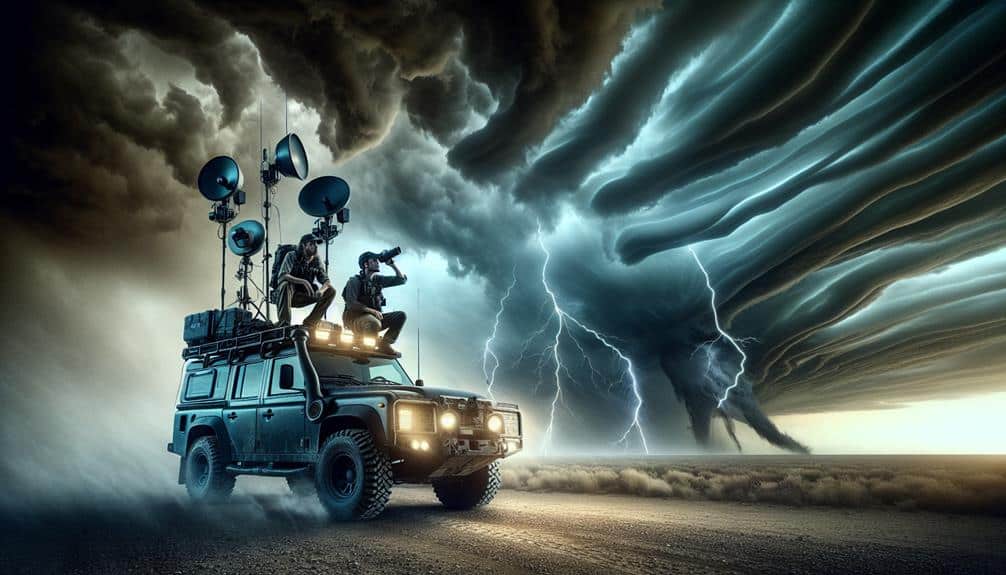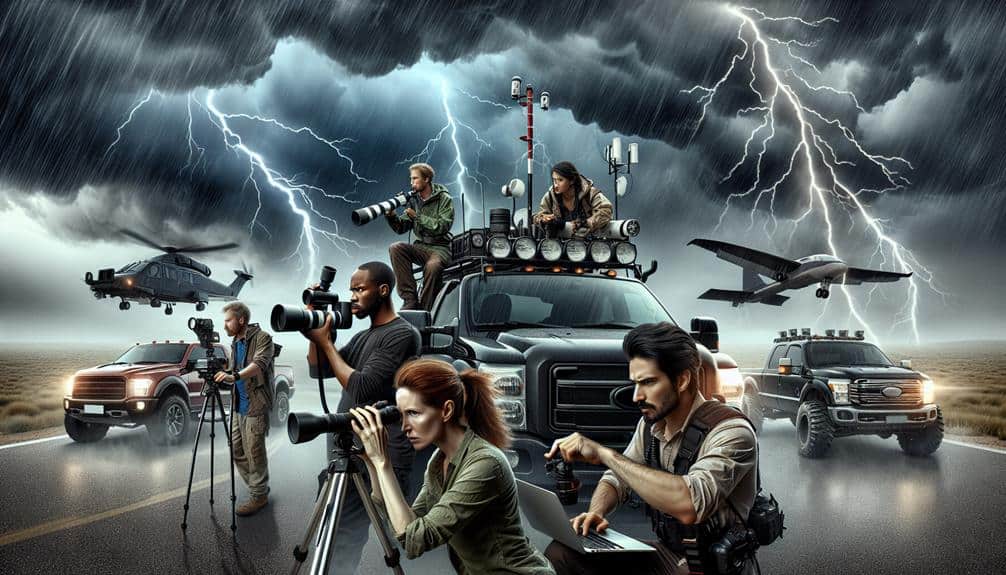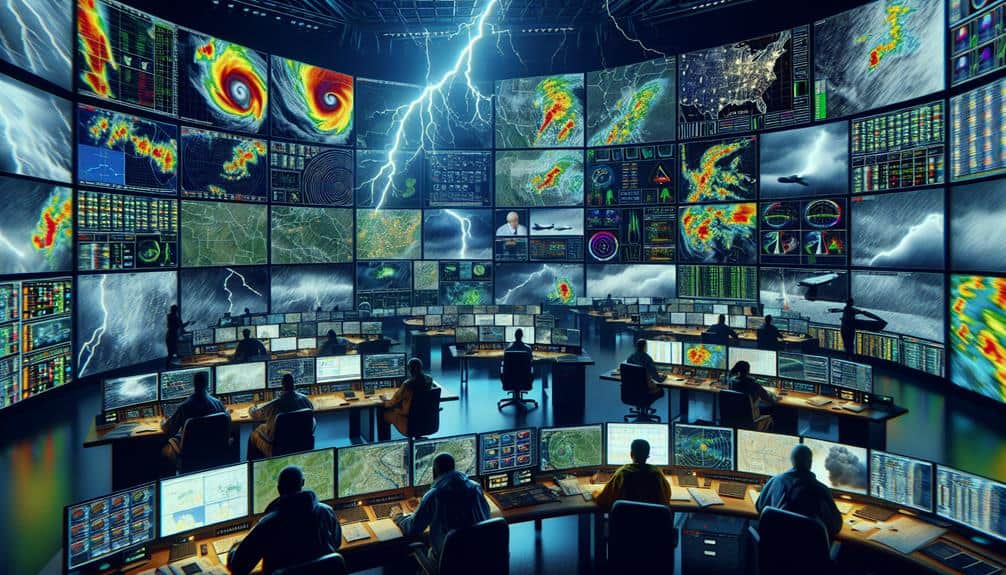To optimize our storm chaser vehicle for safety, we strengthen the structure with high-strength steel and composite materials, engineer crumple zones, and integrate reinforced roll cages. We improve visibility using high-intensity LED lights and reflective markings, and install weather-resistant camera systems. Our advanced weather instruments include reliable sensors and stable mounts, complemented by real-time data transmission and robust communication systems. We upgrade navigation tools with advanced GPS and radars, and equip the vehicle with safety gear like roll bars and harnesses. Routine maintenance of the engine, transmission, and brakes is essential to ensure peak performance and readiness. Let's explore further!
Key Points
- Utilize high-strength steel and advanced composite materials for enhanced impact resistance and lightweight robustness.
- Implement crumple zones and reinforced roll cages for superior occupant protection.
- Equip vehicles with high-intensity LED lights and reflective markings for improved visibility in adverse weather.
- Install reliable meteorological sensors and stable mounts for accurate data capture and vehicle balance.
Reinforcing Vehicle Structure
To guarantee our storm chaser vehicles withstand extreme weather conditions, we must strengthen their structure with high-strength steel and advanced composite materials. High-strength steel provides exceptional impact resistance, vital when facing the unpredictable forces of nature. This material can absorb substantial energy without compromising structural integrity, making sure that our vehicles remain intact even in the most severe storms.
We also incorporate advanced composite materials, known for their lightweight yet incredibly robust properties. These composites enhance the vehicle's stiffness while reducing overall weight, allowing for better maneuverability and fuel efficiency. By strategically placing these materials in crucial areas, such as the frame and undercarriage, we greatly enhance the vehicle's resilience against debris and high winds.
Our vehicle reinforcement strategy involves meticulous engineering and rigorous testing. We employ safety measures like crumple zones and reinforced roll cages to protect occupants in the event of a collision. Each component is designed to work in harmony, providing a strong defense against the harsh elements encountered during storm chasing.
With these enhancements, we ensure that our vehicles not only survive extreme conditions but also offer a secure and reliable platform for our storm chasing adventures.
Enhancing Visibility
To maximize our visibility during severe weather, we need to install high-intensity LED lights that offer superior luminance and energy efficiency.
Additionally, applying reflective vehicle markings guarantees our presence is unmistakable even in low-light conditions.
We should also equip our vehicles with weather-resistant camera systems to maintain clear visuals and gather critical data in extreme environments.
High-Intensity LED Lights
Why do high-intensity LED lights play an important role in storm chaser vehicle safety by greatly enhancing visibility during severe weather conditions?
First, let's consider the unmatched brightness of LED lightbars. These units emit an intense, focused beam that cuts through the most torrential rain, dense fog, and swirling debris, enhancing our ability to navigate treacherous roads. Night visibility is essential when chasing storms, as many severe weather events peak during low-light hours. High-intensity LEDs provide the necessary illumination to spot hazards and keep track of weather patterns.
In addition to their brightness, LED lightbars are incredibly energy-efficient, drawing significantly less power than traditional halogen or incandescent lights. This efficiency ensures that our vehicle's battery isn't overly taxed, allowing us to run other essential electronics, such as communication devices and radar equipment. Furthermore, LEDs have an impressive lifespan, meaning we won't have to worry about frequent replacements during critical moments.
Mounting these LED lightbars strategically around the vehicle maximizes their effectiveness. Front, rear, and side placements ensure a 360-degree field of illumination. This complete lighting setup is crucial when we need to quickly assess our surroundings, make split-second decisions, and maintain safety while chasing the storm.
Reflective Vehicle Markings
Reflective vehicle markings, utilizing high-visibility materials and advanced retro-reflective technology, significantly improve our vehicle's conspicuity in adverse weather conditions, ensuring other drivers can see us even in the darkest and stormiest environments. These safety precautions are vital to our mission. By outfitting our vehicle with reflective decals and strategically placed warning signs, we create a visual alert system that enhances visibility improvements essential for our safety.
We should consider high-intensity reflective decals that utilize microprismatic sheeting. These materials reflect light back to its source, making our vehicle highly visible from a distance. Strategic placement of these decals around the vehicle's perimeter maximizes their effectiveness. For instance, applying them to the rear, sides, and front guarantees that no matter the angle of incoming traffic, our presence is unmistakable.
Additionally, incorporating reflective warning signs with clear, concise messages, such as 'Storm Chaser—Keep Back,' can further enhance our vehicle's visibility. These signs should be made from weather-resistant materials to withstand harsh conditions.
Weather-Resistant Camera Systems
While our reflective vehicle markings greatly improve visibility, integrating weather-resistant camera systems can further enhance our situational awareness and safety during storm chases. By equipping our vehicles with cameras that have waterproof lenses and durable housings, we guarantee they can withstand harsh weather conditions, from heavy rain to hailstorms. These strong systems are crucial for capturing high-quality footage without compromising the integrity of the equipment.
Additionally, advanced camera systems offer remote monitoring capabilities, allowing us to view live feeds from the safety of our vehicles. This feature is crucial when maneuvering challenging terrain or making quick decisions in rapidly changing weather situations. It enables us to monitor the storm's progression while maintaining a safe distance.
Live streaming our footage is another significant benefit. Not only does it enable us to share real-time updates with fellow storm chasers and meteorologists, but it also provides valuable data for weather analysis and forecasting. By incorporating these sophisticated camera systems into our storm chaser vehicles, we improve our ability to document and study severe weather events while prioritizing our safety. This approach ensures that we remain vigilant and informed, regardless of the storm's severity.
Installing Advanced Weather Instruments
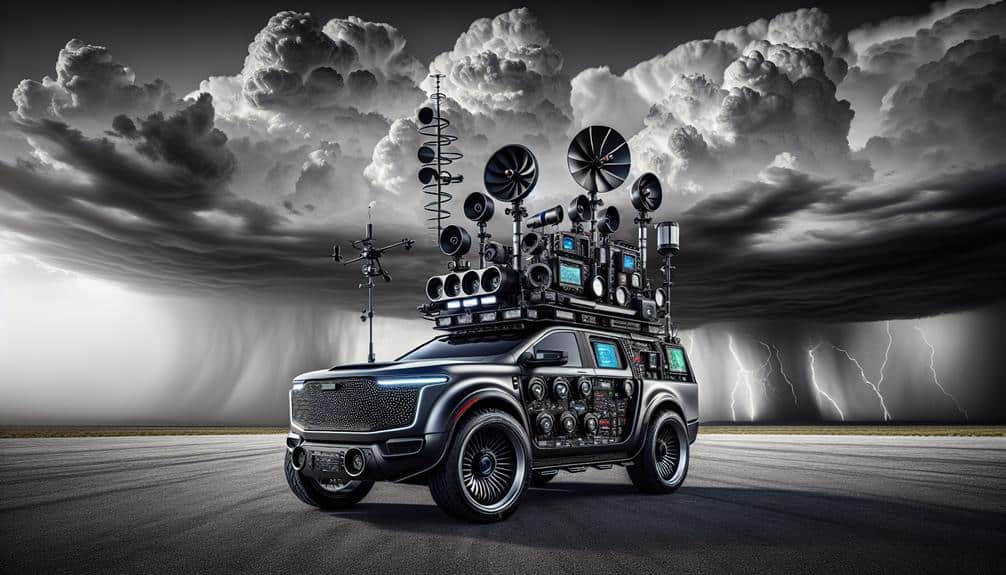
When we install advanced weather instruments, we must prioritize selecting dependable sensors like anemometers and barometers that provide accurate data.
Properly mounting these instruments is essential; we use vibration-resistant brackets and aerodynamic housings to guarantee stability and accuracy.
Additionally, we integrate data loggers and real-time transmission systems to maintain ongoing monitoring.
Choosing Reliable Sensors
Choosing the appropriate sensors for our storm chaser vehicle involves evaluating their accuracy, durability, and compatibility with advanced weather instruments to guarantee reliable data collection. Sensor accuracy is crucial as it ensures we capture vital meteorological parameters like wind speed, barometric pressure, and humidity with precision. High sensor precision translates to high-resolution data, which is essential for real-time analysis and forecasting.
Durability is another crucial factor. Our sensors must withstand extreme weather conditions, including high winds, torrential rain, and debris impact. Opting for ruggedized sensors with protective casings can greatly enhance their lifespan and performance during intense storms. For example, anemometers made with corrosion-resistant materials are less likely to fail under harsh conditions.
Compatibility with advanced weather instruments is key. Our sensors should seamlessly integrate with our data loggers and telemetry systems to facilitate uninterrupted data collection and transmission. Utilizing universal interfaces like RS-232 or USB ports can streamline this process, reducing the chance of compatibility issues.
Ultimately, by meticulously selecting reliable sensors, we equip our storm chaser vehicle with the tools necessary to gather precise, actionable data. This empowers us to navigate storms safely and effectively, giving us the freedom to chase with confidence.
Mounting for Stability
To guarantee our advanced weather instruments remain stable during extreme conditions, we'll need to implement robust mounting solutions that can withstand the challenges of storm chasing. First, proper weight distribution is critical. We must strategically place instruments to maintain vehicle balance, reducing the risk of toppling. Heavier equipment should be positioned lower to keep the center of gravity as close to the ground as possible. This can also necessitate suspension upgrades, ensuring our vehicle can handle additional weight without compromising maneuverability.
Next, let's focus on the roof. Roof racks provide an ideal platform for mounting weather instruments like anemometers and rain gauges. However, these racks must be equipped with secure fastenings to prevent detachment during high winds or sudden movements. Stainless steel brackets and high-tensile bolts are recommended for their durability and corrosion resistance.
Upgrading Communication Systems
Upgrading our communication systems involves integrating state-of-the-art transceivers and satellite links to guarantee real-time data transmission and smooth coordination during storm tracking missions.
Utilizing satellite communication guarantees we stay connected even when cellular networks fail. This capability is vital for receiving emergency alerts and keeping our team informed about sudden changes in storm patterns.
We need to incorporate various radio frequencies for different purposes. High-frequency (HF) radios can reach long distances, while very high frequency (VHF) and ultra-high frequency (UHF) radios provide reliable communication over shorter ranges. These multiple channels allow us to receive real-time updates from weather stations, emergency services, and other storm chasers.
For smooth integration, installing a dual-band transceiver can help us switch between frequencies effortlessly. A robust antenna system is equally necessary for maintaining a strong signal, particularly in remote areas.
Moreover, incorporating a satellite uplink can provide an additional layer of connectivity, making sure we're never out of touch.
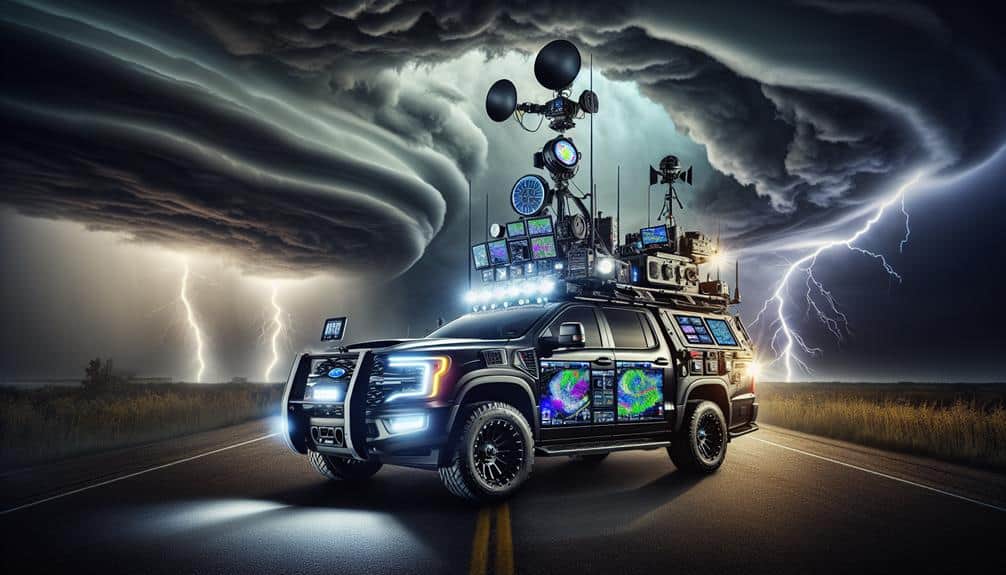
Integrating advanced GPS systems with topographical mapping software will greatly enhance our ability to navigate through severe weather conditions. By leveraging high-precision GPS accuracy, we can pinpoint our exact location even amidst turbulent skies and unpredictable terrains. Modern GPS units equipped with real-time radar integration allow us to visualize storm cells and track their movements, providing an extensive situational awareness essential for storm chasing.
With topographical mapping, we gain insight into elevation changes, road types, and potential obstacles. This detailed data helps us make informed decisions on the fly, ensuring we avoid areas prone to flooding or difficult to traverse. The combination of GPS accuracy and radar integration means we can anticipate changes in weather patterns and adjust our routes accordingly, maximizing our safety while maintaining the thrill of the chase.
Moreover, utilizing mobile apps that sync with our vehicle's navigation system enables seamless updates and remote monitoring. These tools offer dynamic rerouting options, alerting us to new hazards or shifting storm paths. By staying connected and informed, we're not just chasing storms; we're mastering the art of safe navigation, pushing the boundaries of what's achievable while preserving our freedom to explore nature's fiercest elements.
Equipping Safety Gear
Equipping our storm chasing vehicle with state-of-the-art safety gear is essential to safeguarding our well-being amidst unpredictable weather conditions. First, we need to install sturdy roll bars for top-notch impact protection. These bars, strengthened with high-tensile steel, create a safety cage around the vehicle's cabin, significantly reducing the chance of injury during rollovers or collisions with debris.
Next, integrating safety harnesses is vital. Unlike standard seat belts, five-point safety harnesses secure us firmly in our seats, preventing any dangerous movement while maneuvering through turbulent winds and rough terrain. These harnesses distribute force evenly across our bodies, minimizing potential injuries during sudden stops or impacts.
Emergency supplies should be carefully selected. Our kit must include essential first aid items, thermal blankets, water purification tablets, and non-perishable food. Additionally, including a high-visibility vest, portable weather radio, and multi-tool can be extremely valuable during unexpected situations.
Moreover, integrating advanced impact protection features such as energy-absorbing crumple zones and reinforced door panels can greatly enhance our vehicle's resilience against severe weather. These modifications, combined with maintaining clear escape routes and emergency contact protocols, ensure we don't simply pursue storms but do so with a strategic approach to safety.
Maintaining Vehicle Performance

Regularly monitoring and maintaining our vehicle's engine, transmission, and suspension systems guarantees peak performance and reliability during storm chasing expeditions. We can't afford to overlook any aspect of our vehicle's performance, as it's our lifeline when maneuvering through treacherous weather conditions.
Regular maintenance ensures that our engine performance remains at its best. This involves timely oil changes, using high-quality filters, and inspecting spark plugs for wear. Transmission fluid levels should be checked and replaced as necessary to prevent overheating or slippage, which can be catastrophic in the field.
Tire pressure is another critical factor. Underinflated or overinflated tires can lead to poor traction or even blowouts. We should use a reliable tire pressure gauge and adjust to manufacturer specifications before every chase. Additionally, our brake system must be in top condition. This includes checking brake pads, rotors, and fluid levels to guarantee responsive stopping power.
Key maintenance tasks include:
- Engine performance: Regular oil changes, filter replacements, and spark plug inspections.
- Transmission checks: Monitoring fluid levels and condition.
- Tire pressure: Using a reliable gauge and adjusting as needed.
Frequently Asked Questions
What Is the Best Type of Insurance Policy for Storm Chaser Vehicles?
We need an all-inclusive insurance policy with extensive coverage options and high policy limits. This guarantees we're protected against storm-related damages, liability claims, and equipment loss, giving us the freedom to chase storms with peace of mind.
How Do I Secure Funding or Sponsorship for My Storm Chasing Activities?
Securing funding opportunities is a gold mine. We should craft compelling proposals highlighting our unique data collection. For sponsorship tips, target weather-related companies, emphasizing mutual benefits and our technical expertise. Freedom to chase is priceless.
What Should I Pack for a Multi-Day Storm Chasing Trip?
For a multi-day storm chasing trip, we should pack emergency supplies like first aid kits, flashlights, and blankets. Let's bring non-perishable food and water for sustenance. Don't forget navigation tools, weather radios, and communication devices.
Can I Legally Chase Storms in Any State or Region?
We can legally chase storms, but we must follow storm chaser regulations, which vary by state laws. Some states have permission requirements, so it's essential to know local rules and adhere to safety guidelines for responsible chasing.
How Do I Handle Encounters With Law Enforcement While Storm Chasing?
When dealing with authorities while storm chasing, we should remain calm, present our identification, and explain our purpose clearly. Handling police interactions professionally guarantees we can continue our pursuit without unnecessary delays or misunderstandings.
